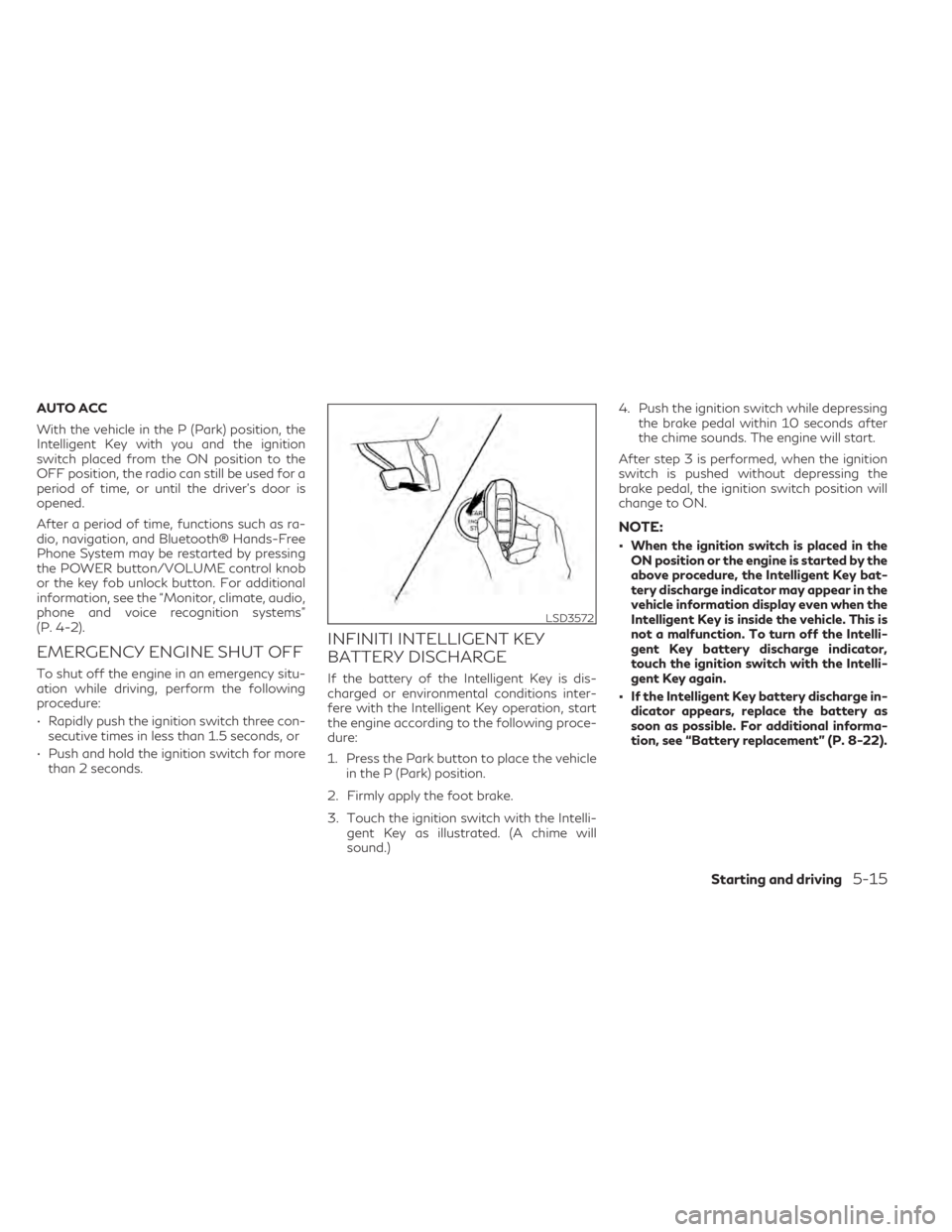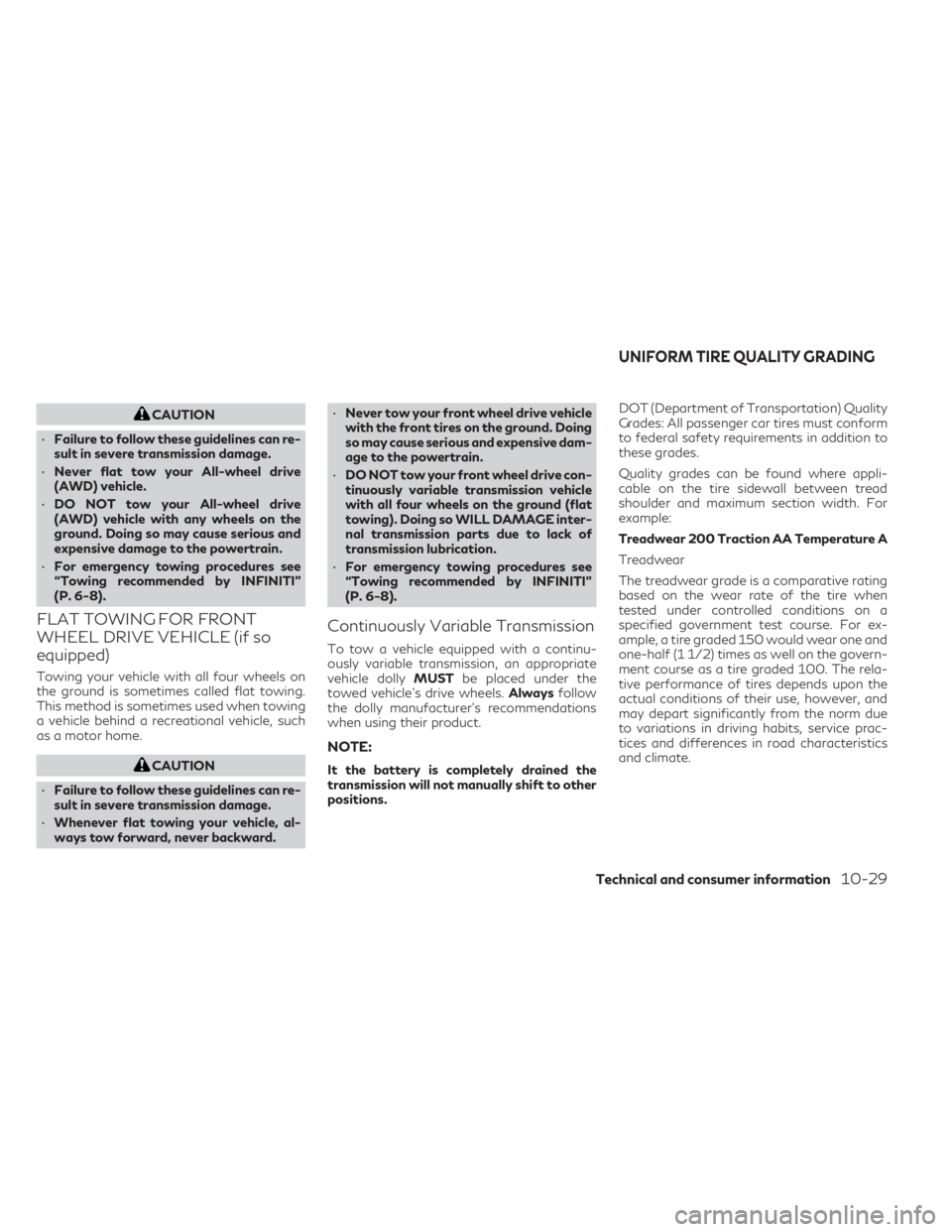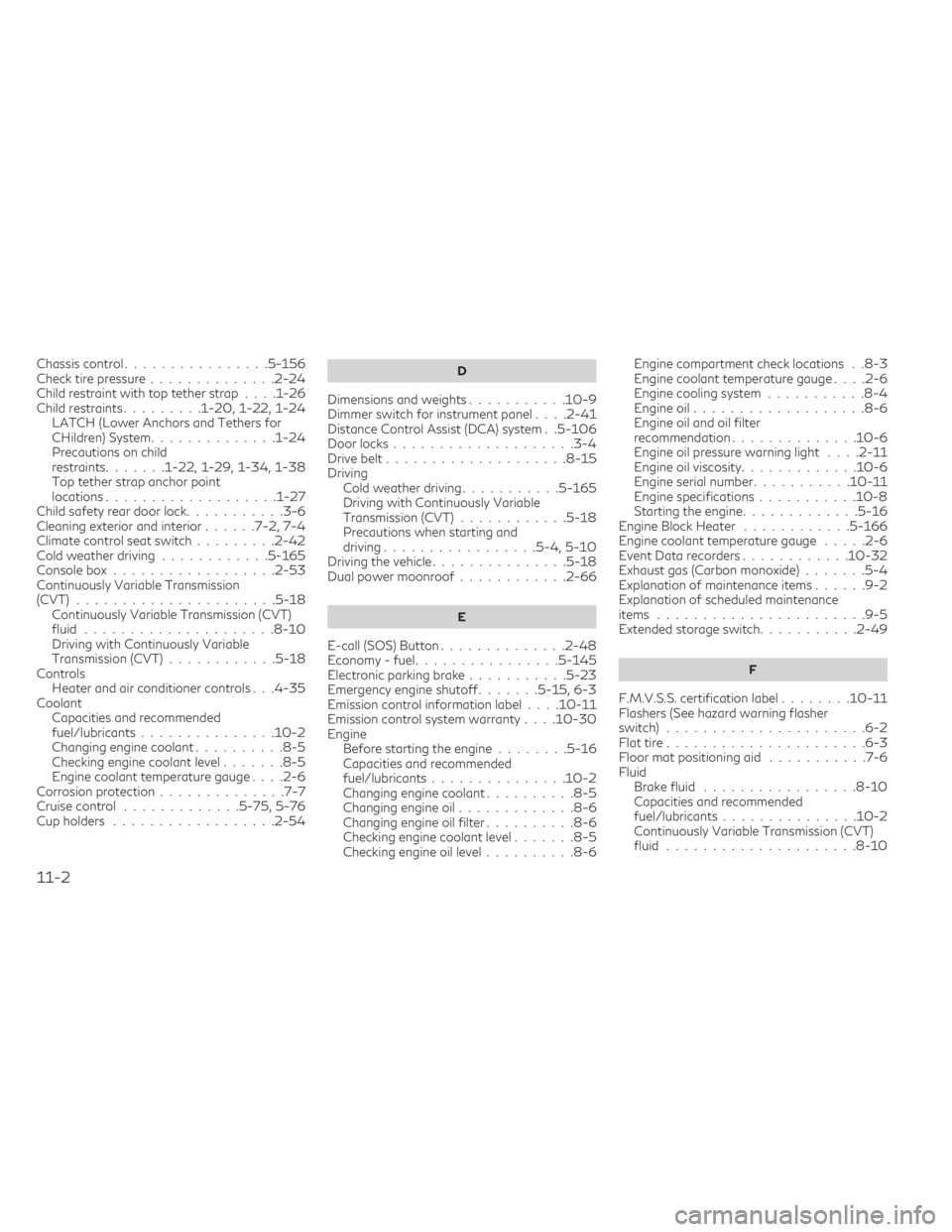climate control INFINITI QX50 2021 Owner's Guide
[x] Cancel search | Manufacturer: INFINITI, Model Year: 2021, Model line: QX50, Model: INFINITI QX50 2021Pages: 542, PDF Size: 3.51 MB
Page 241 of 542

The vehicle is equipped with a shark fin an-
tenna and an antenna pattern is printed in-
side the rear window.
CAUTION
• Do not place metalized film near the rear
window glass or attach any metal parts to
it. This may cause poor reception or noise.
•When cleaning the inside of the rear win-
dow, be careful not to scratch or damage
the rear window antenna. Lightly wipe
along the antenna with a dampened soft
cloth. When installing a CB, ham radio or car phone
in your vehicle, be sure to observe the follow-
ing precautions; otherwise, the new equip-
ment may adversely affect the engine control
system and other electronic parts.
WARNING
• A cellular phone should not be used for
any purpose while driving so full atten-
tion may be given to vehicle operation.
Some jurisdictions prohibit the use of
cellular phones while driving.
• If you must make a call while your vehicle
is in motion, the hands free cellular phone
operational mode is highly recom-
mended. Exercise extreme caution at all
times so full attention may be given to
vehicle operation.
• If you are unable to devote full attention
to vehicle operation while talking on the
phone, pull off the road to a safe location
and stop your vehicle.
CAUTION
• Keep the antenna as far away as possible
from the electronic control modules.
• Keep the antenna wire more than 8 in
(20 cm) away from the electronic control
system harnesses. Do not route the an-
tenna wire next to any harness.
• Adjust the antenna standing-wave ratio
as recommended by the manufacturer.
• Connect the ground wire from the CB
radio chassis to the body.
• For additional information,, it is recom-
mended that you visit an INFINITI re-
tailer for servicing.
LHA4565
2nd row
ANTENNA CAR PHONE OR CB RADIO
Monitor, climate, audio, phone and voice recognition systems4-43
Page 257 of 542

AUTO ACC
With the vehicle in the P (Park) position, the
Intelligent Key with you and the ignition
switch placed from the ON position to the
OFF position, the radio can still be used for a
period of time, or until the driver’s door is
opened.
After a period of time, functions such as ra-
dio, navigation, and Bluetooth® Hands-Free
Phone System may be restarted by pressing
the POWER button/VOLUME control knob
or the key fob unlock button. For additional
information, see the “Monitor, climate, audio,
phone and voice recognition systems”
(P. 4-2).
EMERGENCY ENGINE SHUT OFF
To shut off the engine in an emergency situ-
ation while driving, perform the following
procedure:
• Rapidly push the ignition switch three con-secutive times in less than 1.5 seconds, or
• Push and hold the ignition switch for more than 2 seconds.
INFINITI INTELLIGENT KEY
BATTERY DISCHARGE
If the battery of the Intelligent Key is dis-
charged or environmental conditions inter-
fere with the Intelligent Key operation, start
the engine according to the following proce-
dure:
1. Press the Park button to place the vehicle in the P (Park) position.
2. Firmly apply the foot brake.
3. Touch the ignition switch with the Intelli- gent Key as illustrated. (A chime will
sound.) 4. Push the ignition switch while depressing
the brake pedal within 10 seconds after
the chime sounds. The engine will start.
After step 3 is performed, when the ignition
switch is pushed without depressing the
brake pedal, the ignition switch position will
change to ON.
NOTE:
• When the ignition switch is placed in the ON position or the engine is started by the
above procedure, the Intelligent Key bat-
tery discharge indicator may appear in the
vehicle information display even when the
Intelligent Key is inside the vehicle. This is
not a malfunction. To turn off the Intelli-
gent Key battery discharge indicator,
touch the ignition switch with the Intelli-
gent Key again.
• If the Intelligent Key battery discharge in- dicator appears, replace the battery as
soon as possible. For additional informa-
tion, see “Battery replacement” (P. 8-22).
LSD3572
Starting and driving5-15
Page 525 of 542

CAUTION
• Failure to follow these guidelines can re-
sult in severe transmission damage.
• Never flat tow your All-wheel drive
(AWD) vehicle.
• DO NOT tow your All-wheel drive
(AWD) vehicle with any wheels on the
ground. Doing so may cause serious and
expensive damage to the powertrain.
• For emergency towing procedures see
“Towing recommended by INFINITI”
(P. 6-8).
FLAT TOWING FOR FRONT
WHEEL DRIVE VEHICLE (if so
equipped)
Towing your vehicle with all four wheels on
the ground is sometimes called flat towing.
This method is sometimes used when towing
a vehicle behind a recreational vehicle, such
as a motor home.
CAUTION
• Failure to follow these guidelines can re-
sult in severe transmission damage.
• Whenever flat towing your vehicle, al-
ways tow forward, never backward. •
Never tow your front wheel drive vehicle
with the front tires on the ground. Doing
so may cause serious and expensive dam-
age to the powertrain.
• DO NOT tow your front wheel drive con-
tinuously variable transmission vehicle
with all four wheels on the ground (flat
towing). Doing so WILL DAMAGE inter-
nal transmission parts due to lack of
transmission lubrication.
• For emergency towing procedures see
“Towing recommended by INFINITI”
(P. 6-8).
Continuously Variable Transmission
To tow a vehicle equipped with a continu-
ously variable transmission, an appropriate
vehicle dolly MUSTbe placed under the
towed vehicle's drive wheels. Alwaysfollow
the dolly manufacturer's recommendations
when using their product.
NOTE:
It the battery is completely drained the
transmission will not manually shift to other
positions. DOT (Department of Transportation) Quality
Grades: All passenger car tires must conform
to federal safety requirements in addition to
these grades.
Quality grades can be found where appli-
cable on the tire sidewall between tread
shoulder and maximum section width. For
example:
Treadwear 200 Traction AA Temperature A
Treadwear
The treadwear grade is a comparative rating
based on the wear rate of the tire when
tested under controlled conditions on a
specified government test course. For ex-
ample, a tire graded 150 would wear one and
one-half (1 1/2) times as well on the govern-
ment course as a tire graded 100. The rela-
tive performance of tires depends upon the
actual conditions of their use, however, and
may depart significantly from the norm due
to variations in driving habits, service prac-
tices and differences in road characteristics
and climate.
UNIFORM TIRE QUALITY GRADING
Technical and consumer information10-29
Page 532 of 542

Chassis control................5-156Check tire pressure..............2-24Child restraint with top tether strap. . . .1-26Child restraints.........1-20, 1-22, 1-24LATCH (Lower Anchors and Tethers for
CHildren) System..............1-24Precautions on child
restraints.......1-22, 1-29, 1-34, 1-38Top tether strap anchor point
locations.................. .1-27Child safety rear door lock...........3-6Cleaning exterior and interior......7-2, 7-4Climate control seat switch.........2-42Cold weather driving........... .5-165Console box................. .2-53Continuously Variable Transmission
(CVT)..................... .5-18Continuously Variable Transmission (CVT)
fluid.....................8-10Driving with Continuously Variable
Transmission (CVT)............5-18Controls
Heater and air conditioner controls. . .4-35CoolantCapacities and recommended
fuel/lubricants
.............. .10-2Changing engine coolant..........8-5Checking engine coolant level.......8-5Engine coolant temperature gauge. . . .2-6Corrosion protection..............7-7Cruise control.............5-75, 5-76Cup holders................. .2-54
D
Dimensions and weights...........10-9Dimmer switch for instrument panel. . . .2-41Distance Control Assist (DCA) system. .5-106Door locks................... .3-4Drive belt....................8-15Driving
Cold weather driving.......... .5-165Driving with Continuously Variable
Transmission (CVT)........... .5-18Precautions when starting and
driving................ .5-4, 5-10Driving the vehicle...............5-18Dual power moonroof............2-66
E
E-call (SOS) Button............. .2-48Economy - fuel............... .5-145Electronic parking brake...........5-23Emergency engine shutoff.......5-15, 6-3Emission control information label. . . .10-11Emission control system warranty. . . .10-30Engine
Before starting the engine........5-16Capacities and recommended
fuel/lubricants.............. .10-2Changing engine coolant..........8-5Changing engine oil.............8-6Changing engine oil filter..........8-6Checking engine coolant level.......8-5Checking engine oil level..........8-6
Engine compartment check locations. .8-3Engine coolant temperature gauge. . . .2-6Engine cooling system...........8-4Engine oil.................. .8-6Engine oil and oil filter
recommendation..............10-6Engine oil pressure warning light. . . .2-11Engine oil viscosity.............10-6Engine serial number...........10-11Engine specifications...........10-8Starting the engine............ .5-16Engine Block Heater............5-166Engine coolant temperature gauge. . . . .2-6Event Data recorders............10-32Exhaust gas (Carbon monoxide).......5-4Explanation of maintenance items......9-2Explanation of scheduled maintenance
items...................... .9-5Extended storage switch...........2-49
F
F.M.V.S.S. certification label........10-11Flashers (See hazard warning flasher
switch)..................... .6-2Flat tire......................6-3Floor mat positioning aid...........7-6Fluid
Brake fluid................ .8-10Capacities and recommended
fuel/lubricants...............10-2Continuously Variable Transmission (CVT)
fluid.................... .8-10
11-2